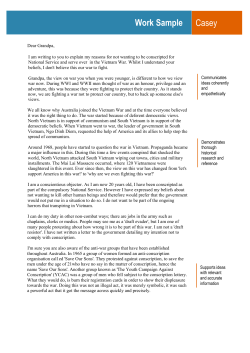
Learning Outcomes, School Quality and Inequality in Vietnam, Peru
Learning Outcomes, School Quality and Inequality in Vietnam, India, Peru and Ethiopia Caine Rolleston YOUNG LIVES HOUSEHOLD STUDY Young Lives longitudinal survey of children, households & communities every 3 years since 2002 • • • • • 12,000 index children Two cohorts now aged 13 and 19 Ethiopia, India, Peru, Vietnam 20 sentinel sites in each country Include comparable learning assessments of maths and literacy SCHOOL SURVEYS • School surveys since 2010 • Focus on learning & learning progress, school and teacher effectiveness • Index children and their class peers • Total 3,284 pupils in Grade 5 in Vietnam, 176 classes in 91 school sites • Longitudinal test design reflect curricular expectations at the beginning and the end of the school year • School, class observations, teacher pedagogical content tests, attitude questionnaires • Allows estimation of school quality GNI IS HIGHEST IN PERU AND VERY SIMILAR IN VIETNAM AND INDIA GNI per capita 1995-2010 ($ 2000, PPP) 8000 7000 6000 5000 Peru 4000 Vietnam 3000 India Ethiopia 2000 1000 2010 2009 2008 2007 2006 2005 2004 2003 2002 2001 2000 1999 1998 1997 1996 1995 0 HOUSEHOLD TEST DATA: AT AGE 5 COGNITIVE DEVELOPMENT LEVELS ARE SIMILAR, ESPECIALLY BETWEEN VIETNAM AND INDIA Mean Score (%) BY AGE 8 CHILDREN IN VIETNAM OUTPERFORM OTHER COUNTRIES IN MATHS. The POOREST IN VIETNAM PERFORM BETTER THAN ALMOST ALL OTHERS Mean (Household) Maths Test Scores at Age 8 (%) BY AGE 15 THE GAP IN MATHS PERFORMANCE BETWEEN VIETNAM AND INDIA IS VERY LARGE Site-level average maths score at age 14-15 20 18 16 14 12 10 8 6 4 2 0 India Vietnam 0 20 40 60 80 WIDENING GAPS ARE DRIVEN BY DIFFERENCES IN LEARNING PROGRESS OVER TIME BETWEEN SYSTEMS: AGE 5 TO 8 0 20 40 60 CDA-Q Score R2 % Ethiopia India 80 Peru Vietnam 100 PROGRESS AGES 12 TO 15 WHILE PUPILS IN VIETNAM KEEP UP WITH THE CURRICULUM, IN INDIA THEY FALL PROGRESSIVELY BEHIND Pupils’ abilities remain in-line with the curriculum in Vietnam but the curriculum in India is progressively ‘over-ambitious’ (pupils fail to progress according to expectations) VIETNAM AND INDIA: SCHOOL-SYSTEM QUALITY INDICATORS (FROM SCHOOL SURVEYS) Indicator Mean class size Vietnam 27.61 16.23 Mean years of teacher experience 17.47 7.71 Mean monthly teacher salary (USD/Month) % of teachers with no formal teacher training qualification 164 226 0% 16.50% Teacher absenteeism 2.34 days per year 35.12% pupils said ‘ my class teacher often does not come to school’ 96.16% 60.84% All children have access to maths textbooks Teacher always checks/marks maths homework 41.28% India 18.06% THE REASON FOR BETTER PERFORMANCE OVERALL IN VIETNAM LIES PARTLY IN LOWER LEVELS OF INEQUALITY HIGH AVERAGE PERFORMANANCE LINKED TO LOW DISPERSION TEST SCORES VARY BETWEEN SCHOOLS IN PERU AND VIETNAM BUT ARE LESS DISPERSED IN VIETNAM 10 0 5 Number of Schools 15 20 School Mean Maths Scores, Vietnam 300 400 500 Mean Maths Score 600 700 10 5 0 Number of Schools 15 20 School Mean Maths Scores, Peru 300 400 500 Mean Maths Score 600 700 School test scores scaled to mean 500 and standard deviation 100 THE RELATIONSHIP BETWEEN TEST SCORES AND HOME BACKGROUND IS STRONGER IN PERU THAN VIETNAM 400 450 500 550 600 Maths Performance By Wealth Index 0 .25 .5 Household Wealth Index 95% CI Peru .75 Vietnam 1 IN VIETNAM, ETHNIC MINORITY PUPILS PERFORM LESS WELL THAN KINH, BUT NO EVIDENCE THAT THE GAP WIDENS DUE TO SCHOOLING IN G5 Maths Vietnamese First Test Second Test Gain First Test Second Test Gain Kinh 508.74 549.77 41.03 511.41 513.32 1.90 Ethnic Minority 438.55 503.66 65.12 419.76 481.31 61.55 Difference 70.19*** 46.11*** 24.08*** 91.65*** 32.01*** 59.65*** Total 500.00 544.03 44.03 500.00 509.33 9.33 Vietnamese Mathematics DIFFERENT GROUPS OF CHILDREN MAY BENEFIT FROM SCHOOL QUALITY DIFFERENTLY There are 2 main ways through which school quality may have differential impacts on pupils’ attainments. Differential school effectiveness along SES BETWEEN SCHOOLS WITHIN SCHOOLS Are poorer children accessing lower quality schools? Are poorer children benefiting less from school quality than their more advantaged counterparts? (selection into schools) UNEQUAL ACCESS: PRIVATE SCHOOL ATTENANCE IS ACCELERATING IN RURAL INDIA WITH A WIDENING GENDER GAP 100 SOME SCHOOLS ARE MORE EFFECTIVE THAN OTHERS IN VIETNAM, BUT THIS IS NOT STRONGLY LINKED TO PUPILS’ BACKGROUNDS Which Schools Add More Value in G5? 50 Not particularly more advantaged pupils 0 Slightly better physical resources -50 Not better teacher subject knowledge More teachers with degrees -100 More positive teacher attitudes e.g. 0 10 20 30 School Value-Added Rank 40 50 “The influence of a student’s home experience can be overcome by good teaching” School Value-Added: Learning progress attributable to schools after removing prior attainment and background effects Teachers more often evaluated CHILDREN’S HOME BACKGROUNDS EXPLAIN MORE OF THE VARIANCE IN ATTAINMENT IN INDIA AND PERU THAN IN VIETNAM Controlling for pre-school scores, children’s home backgrounds (at age 5) explain much more of the variation in test scores (at age 11) in Peru than in Vietnam or India Proportion of Variance in Test Scores Explained 0.4 0.35 0.3 0.25 In maths, backgrounds account for a large proportion of the variance in Peru and much less in Vietnam 0.2 0.15 Systems where background effects are large are arguably more inequitable - ‘reproducing’ home advantage/disadvantage 0.1 0.05 0 Vietnam Mathematics India Language Peru SCHOOLS EXPLAIN MORE OF THE VARIANCE IN ATTAINMENT IN INDIA AND PERU COMPARED WITH VIETNAM Proportion of Variance in Test Scores Explained 0.6 • ‘School fixed effects’ capture school-level factors (school quality), controlling for pupil backgrounds, pre-school test scores 0.5 0.4 • School quality in India and Peru accounts for more of the variance in test scores than in Vietnam 0.3 0.2 0.1 0 Vietnam Mathematics India Language Peru • School systems in Peru and India more heterogeneous, school a child attends appears to matter more than in Vietnam WITHIN THE SAME SCHOOL, DISADVANTAGED PUPILS MAKE LESS PROGRESS IN PERU, BUT NOT IN VIETNAM 0.5 Who benefits from an increase in school quality? – compare effect on richest 40% to poorest 60% (separate FE) 0.41* 0.4 0.3 0.2 0.1 Proportion of 1 SD of maths test score distribution 0 -0.1 -0.2 -0.18 -0.3 Vietnam Peru In Vietnam, schools are equally effective in teaching Maths to children irrespectively of their background. In Peru, by contrast, schools significantly less effective at teaching children from disadvantaged backgrounds POSITIVES • Almost all schools have basic facilities - electricity, toilets, text books, basic learning materials etc. • Overall differences across sites on basic quality indicators are small • Pupils from disadvantaged sites/backgrounds make good progress on the curriculum in G5 • Disadvantaged pupils attend schools with lower levels of some assets but are often in smaller classes • The relationship between school quality and pupils’ backgrounds is fairly weak • Primary schooling in Vietnam is relatively equitable by comparison TEACHERS IN VIETNAM KNOW WHAT PUPILS KNOW (AND NEED TO KNOW) Young Lives Test Score 650 600 550 500 450 400 1 2 3 4 5 6 7 Teacher Reported Test Score 8 9 10 CAVEATS • Large differences in home background advantage between sites • Large differences in achievement between the most (urban Da Nang) and least advantaged sites (mountainous Lao Cai) • Notable differences in test score by ethnicity (Kinh/minority) • Larger differences on more sophisticated school resources (i.e. library, internet, computers), particularly between Da Nang and the other sites • Pupils in more advantaged sites receive more periods of teaching per week • Effects of extra classes etc. difficult to account for • Gaps at entry to Grade 5 require further efforts to equalise learning very early on. DROP-OUT BETWEEN AGES12 AND 15 IS HIGHEST IN VIETNAM • High drop-out at completion of junior secondary stage (age 14) • Higher among boys • May suggest PISA results are an overestimate PUPILS IN VIETNAM PERFORM VERY WELL ON EQUATIONS AND ALGEBRA INCLUDING USING COMPLEX FRACTIONS …BUT POORLY ON SIMPLER? PROBLEM SOLVING QUESTIONS (SUGGESTING ROTE LEARNING) 39% 33% WHAT IS DIFFERENT ABOUT THE VIETNAMESE SYSTEM? Equity-oriented centralised public school system • Less evidence that disadvantaged pupils attend lower quality schools • Less evidence that schools are less effective for disadvantaged pupils High-performance for the majority linked to equity orientation • Emphasis on ‘fundamental’ or minimum school quality levels (especially in disadvantaged areas) • Common curricula & text books in use matched closely to pupils’ learning levels • Commitment to ‘mastery’ by all pupils - use of regular assessment by teachers • Teacher knowledge (YL curriculum tests) is similar between more and less disadvantaged areas, absenteeism is low across almost all schools FINDING OUT MORE caine.rolleston@qeh.ox.ac.uk www.younglives.org.uk
© Copyright 2025









